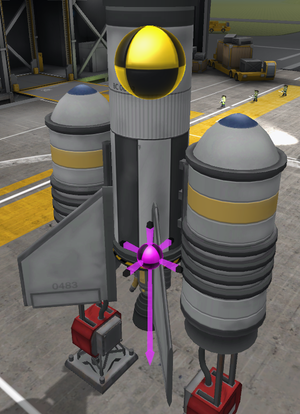Difference between revisions of "Center of thrust"
m (Grammar and spelling) |
m (→Reading the Center of Thrust) |
||
| Line 12: | Line 12: | ||
The center of thrust is used mainly to determine a rocket's behavior in flight by comparing its position to the center of mass. It's basically the same as the center of lift but this is generated by engines rather than wings. If the COT is left of the COM then the rocket tilts right, too far right, and it tilts left. It behaves similarly if it is too far forward or backwards. | The center of thrust is used mainly to determine a rocket's behavior in flight by comparing its position to the center of mass. It's basically the same as the center of lift but this is generated by engines rather than wings. If the COT is left of the COM then the rocket tilts right, too far right, and it tilts left. It behaves similarly if it is too far forward or backwards. | ||
| − | The COT should also be pointing at the COM as well, if it is pointing away from the COM then the rocket will be top-heavy and be prone to tilting. This is usually called the pendulum rocket fallacy. In Kerbal | + | The COT should also be pointing at the COM as well, if it is pointing away from the COM then the rocket will be top-heavy and be prone to tilting. This is usually called the pendulum rocket fallacy. In Kerbal Space Program, such crafts will be less efficient, as [[thrust vectoring]] needs to be applied to keep the craft pointing straight, and the thrust spent doing that is no longer available to push the rocket up like it normally would be. Steering problems can be fixed by adding engines with [[thrust vectoring]], adding an [[RCS]], or adding [[control surface]]s. |
== See also == | == See also == | ||
Revision as of 04:39, 13 January 2015
The center of thrust (abbreviated COT) is the direction in which the thrust is acting and on which point the thrust is acting on. Because it has also a direction component it's usually called thrust vector. The COT and center of mass should be in one line to minimize steering losses. It is important to note that the COT is calculated based on all running engines on the craft and not just the engines in any individual stage. The center of thrust will change when engines get activated, deactivated or run out of fuel. Also when the craft's configuration changes, due to docking with other craft or jettisoning parts, the thrust vector will change.
Is one of the three “centers” displayed in the VAB and Spaceplane Hangar along with the center of lift and center of mass abbreviated COL and COM respectively.
Reading the Center of Thrust
The center of thrust is used mainly to determine a rocket's behavior in flight by comparing its position to the center of mass. It's basically the same as the center of lift but this is generated by engines rather than wings. If the COT is left of the COM then the rocket tilts right, too far right, and it tilts left. It behaves similarly if it is too far forward or backwards.
The COT should also be pointing at the COM as well, if it is pointing away from the COM then the rocket will be top-heavy and be prone to tilting. This is usually called the pendulum rocket fallacy. In Kerbal Space Program, such crafts will be less efficient, as thrust vectoring needs to be applied to keep the craft pointing straight, and the thrust spent doing that is no longer available to push the rocket up like it normally would be. Steering problems can be fixed by adding engines with thrust vectoring, adding an RCS, or adding control surfaces.
See also
- Center of lift
- Center of mass
- Pendulum rocket fallacy on Wikipedia
